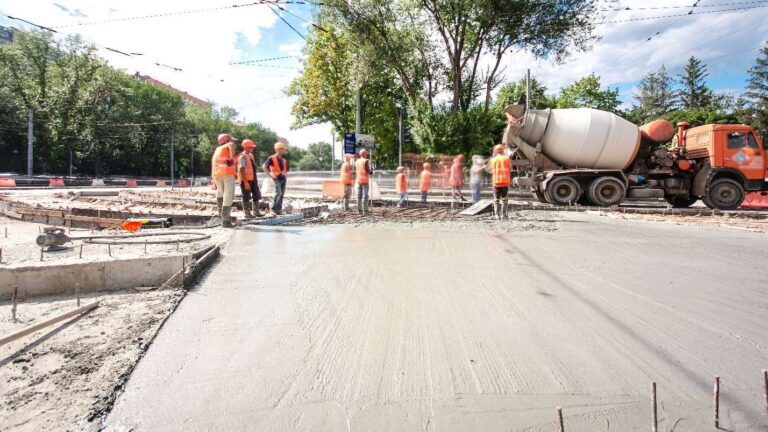
Bringing new crew members onto a concrete job isn’t just about handing them a trowel and saying “go.” When the success of a pour hinges on grade, form layout, and timing, training rookies right from the start can make or break the job. Whether you’re prepping a driveway crew or onboarding laborers for commercial slabs, this guide brings you field-tested strategies for setting them up for success.
At Stevenson Supply & Tractor Co., we’ve outfitted concrete crews across Northern California for decades with the concrete contractor tools Mendocino County and beyond to get the job done right! From foundation footings in Ukiah to flatwork along the coast, we understand the challenges of concrete layout and preparation in our region. We also know that well-trained crews deliver better results, cut down on rework, and keep projects moving forward. If you’re a foreman, lead, or owner looking to build a more reliable crew, this one’s for you!
Concrete doesn’t offer do-overs. Once it’s poured, any misalignment in layout, formwork, or grade becomes a costly, time-consuming problem. And with increasing complexity in commercial and custom residential projects, entry-level workers need more than a strong back, they need layout know-how.
In our hilly and often unpredictable Mendocino terrain, knowing how to handle slopes, drainage, and shifting soils is a skill in itself. That’s why we recommend shadowing experienced crew on different project types, from sidewalks to slab-on-grade, to see how prep, layout, and execution vary across conditions.
Before pouring any slab, make sure your new hires are grounded in these key concepts:
New hires need to understand that the layout isn’t just busy work, it’s the framework for every part of the job. Teach them:
Use real examples: show them how improper slope on a slab leads to water pooling, or how a crooked form can delay a pour. Walk them through elevation differences with a rotary laser and explain how even ½” can matter when tying into adjacent structures.
Concrete layout and prep rely on a specialized set of tools that must be used properly. Ensure your new crew gets hands-on with:
Let them carry, set up, and operate tools, repetition builds confidence. Reinforce habits like checking for laser calibration or securing stake lines to prevent shifting during setup. Don’t assume they’ll ask questions, walk them through best practices and make sure they understand why accuracy matters.
Before a single formboard goes up, your crew should know how to:
Use this stage to spot detail-oriented workers. The ones who double-check measurements and ask about soil conditions are often the ones who grow into layout leads or finishers.
Laser levels, smart levels, and layout gear can overwhelm a new hire. Here’s a smart way to phase them in:
Watch the layout team set forms or check elevations
Carry gear, hold grade rods, or hammer in stakes
Use laser levels to verify grade, check distances, confirm square
Assign them a small area to layout, then review and correct together
Training this way ensures they learn without risking jobsite errors. Start simple, sidewalks and pads, before assigning them to more complex foundation layouts.
Generic advice doesn’t work in the field. Teach layout and prep in the context of your project types:
Localized training sticks. Your crew will remember how to work on a slope when they’ve done it, not just heard about it.
Put together a field binder or app folder that includes:
Laminated or waterproof pages go a long way. If you’re sourcing tools from Stevenson Supply, ask us about specification sheets, we can include them with any new gear.
Concrete crews deal with heavy materials, sharp tools, and fast timelines. Teach your new hires:
Walking them through how to communicate hazards clearly, this builds a culture of care and attention from day one.
Good layout requires clear communication, especially across noisy sites. Teach:
Then start giving new hires small responsibilities like:
Small ownership builds pride and weeds out those not ready to contribute.
Partnering with a local supplier like Stevenson Supply & Tractor Co. means more than just access to tools. It means:
We’ve worked with flatwork crews, foundation subs, and finishers up and down the coast. Whether you’re laying curb and gutter or a full commercial slab, we know what gear holds up and how to use it well.
Successful concrete jobs don’t start with the pour, they start with a trained team that knows how to set up right. Make training a daily habit, not a one-time event.
Because just like your forms, your crew needs a solid foundation.
At Stevenson Supply & Tractor Co., we’re proud to serve Northern California’s hardest-working concrete crews. From laser levels to layout string to concrete blades, we stock the concrete contractor tools you trust and the support you need to keep every job moving forward.
Call us at (707) 575-3335, contact us online, or stop by the shop! We’re here to help your team build stronger, straighter, smarter.
President/CEO
Kent Stevenson is the owner and president of Stevenson Supply & Tractor Co., a family-owned equipment and supply company serving Sonoma County and the North Bay agricultural community since 1967. Under Kent’s leadership, the company has expanded from a small tractor dealership into a trusted regional provider of agricultural equipment, hardware, fencing, and repair services.
Kent is known for his deep agricultural knowledge, hands-on approach, and commitment to serving the local farming and vineyard community. His business philosophy blends old-fashioned service with modern efficiency, ensuring every customer—from homeowners to commercial growers—receives honest guidance and reliable equipment solutions.
Stevenson Supply continues to reflect the values Kent grew up with: hard work, integrity, and dedication to supporting the people who keep Sonoma County growing.